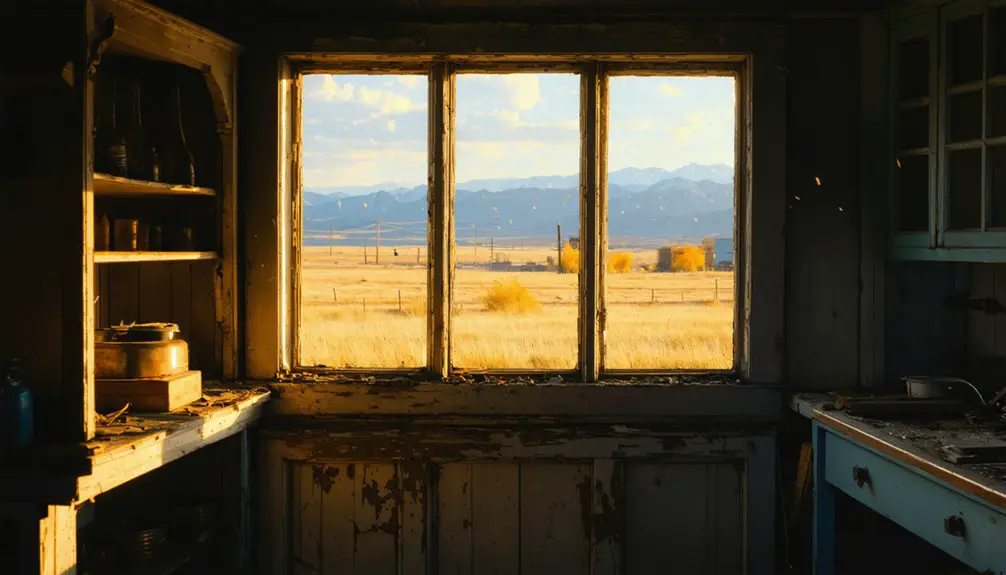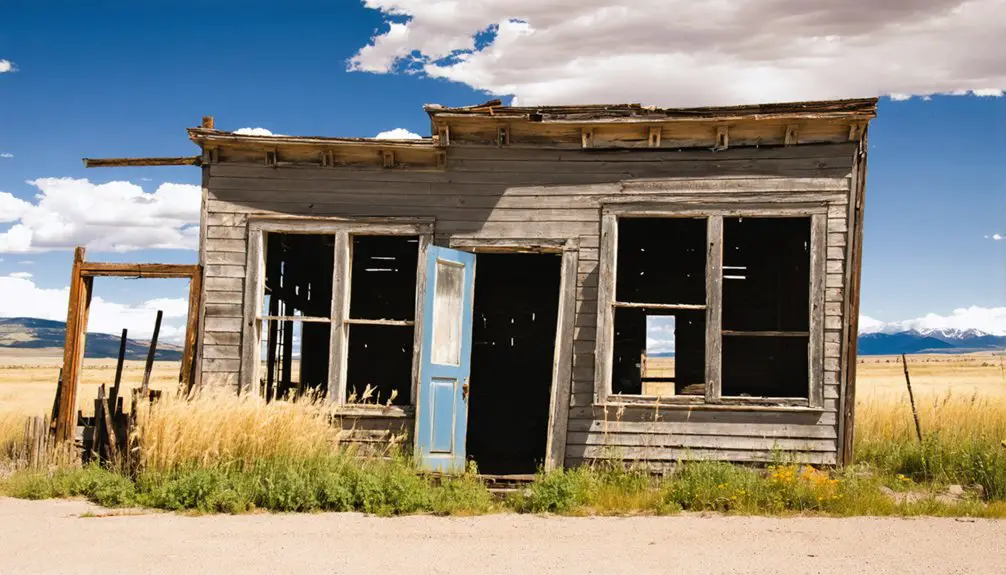You’ll find the ghost town of Coulson along the Yellowstone River near modern-day Billings, Montana. Founded in 1877 as a steamboat hub, this frontier settlement boasted hotels, saloons, and Perry McAdow’s bustling sawmill. When the Northern Pacific Railroad bypassed Coulson in 1882, residents abandoned the town for nearby Billings. Today, Boothill Cemetery and Coulson Park mark the site where this once-promising river town stood, each holding stories of Montana’s pioneering spirit.
Key Takeaways
- Coulson was Montana Territory’s first Yellowstone Valley town, founded in 1877 along the Yellowstone River as a steamship trading hub.
- The town became a ghost town after the Northern Pacific Railroad bypassed it in 1882, establishing Billings two miles away instead.
- Most buildings and businesses were physically moved from Coulson to the new town of Billings, leaving the original site largely abandoned.
- Only Boothill Cemetery remains as a physical reminder of Coulson, earning National Register status in 1979 and maintained by Billings.
- Coulson Park now marks the ghost town’s original location, preserving the history of this once-bustling riverside settlement.
The Rise of a Frontier River Town
In 1877, settlers from Montana Territory’s Gallatin Valley established Coulson as the Yellowstone Valley‘s first permanent settlement, strategically positioning it along the north bank of the Yellowstone River.
Named after the Coulson Packet Company, the town’s founders envisioned it becoming a thriving hub for steamship commerce.
You’ll find that settlement challenges shaped Coulson’s early character. The town started with basic amenities – tents, the International Hotel, and makeshift stores catering to settlers and travelers. The town’s reputation for saloons and entertainment drew many young men seeking adventure.
River commerce proved disappointing, as steamships rarely ventured this far upriver. The rough frontier atmosphere attracted characters like “Liver-Eating Johnson,” while frequent gunplay and conflicts became commonplace. The town would eventually be overtaken by nearby Billings, which was founded in 1882.
Despite lacking formal structures like churches, the town persisted through its early years, adapting to the harsh realities of frontier life.
Life Along the Yellowstone River
While Native American tribes had long inhabited the Yellowstone River valley seasonally, life along the river underwent dramatic changes as settlers arrived in the late 1800s.
The Yellowstone River valley transformed as settlers displaced Native Americans’ seasonal rhythms with permanent settlements and new land uses.
You’d have found a complex pattern of seasonal migration among tribes like the Crow, Shoshone, and Blackfeet, who followed bison herds and gathered resources throughout the year. The Sheepeater Shoshone were unique, making their home year-round within what’s now Yellowstone Park. The Crow Indians dominated much of the region until Jim Bridger wintered with them near Emigrant in 1844-45. Father De Smet began missionary work among the Crow in 1840, marking early religious influence in the region.
As trappers and traders established posts along the river, they created hubs of commerce that transformed traditional resource management.
You’d have seen the valley change even more dramatically when irrigation projects began in the late 1870s, converting semi-arid lands into productive farms and permanently altering both the landscape and way of life.
Notable Pioneers and Early Settlers
Several prominent pioneers shaped Coulson’s early development along the Yellowstone River in the late 1870s.
You’ll find I.D. O’Donnell’s pioneer contributions in preserving the town’s cemetery and history, while John Alderson’s National Hotel put the settlement on the map. Civil War veteran Alonzo Young left his mark with Young’s Point landmark, and Luther “Yellowstone” Kelly’s legacy lives on through a monument near town.
Despite settlement challenges, these early settlers built Coulson’s foundation through trading posts and river commerce. Perry Mikado established a key river fording spot that helped launch steamboat operations between St. Louis and Montana.
Paul McCormick established essential trade routes, while Horace Countryman founded the nearby Stillwater trading post.
The town drew determined pioneers who secured family burial plots in Coulson Cemetery, showing their commitment to building a lasting community along the Yellowstone’s banks. Their plots were distinguished by Victorian cast-iron fences that marked the family boundaries.
Commerce and Trade in Early Coulson
Founded in 1877 along the Yellowstone River, Coulson emerged as a strategic trading post named after the Coulson Steamboat Packet Company. While steamship trade never fully materialized, early commerce centered around Perry W. McAdow’s general store and sawmill, which supplied crucial trade goods to settlers and railroad workers.
You’d find tents and basic establishments dotting the riverside, offering supplies, food, and lodging to travelers. McAdow and T.S. Wadsworth established the first streetcar line in Montana to transport people between Coulson and Billings. The Yellowstone River proved essential for commerce, powering the sawmill and providing irrigation through the Coulson Ditch. For additional historical details, the Billings Gazette maintains extensive archives about Coulson’s commercial activities.
However, when the Northern Pacific Railroad bypassed Coulson for Billings in 1882, businesses quickly relocated two miles away. Today, no original commercial buildings remain at the Coulson site, though its brief but significant trading legacy lives on in Billings’ historical monuments.
The Nez Perce Conflict’s Impact
During the tumultuous Nez Perce War of 1877, Coulson found itself caught in the crossfire as Chief Joseph’s band fled through Montana. The conflict brought significant cultural disruption as warriors raided local properties, burning a shack and saloon. After months of strategic maneuvers covering fifteen hundred miles, the Nez Perce would eventually surrender at Bear Paw. Despite their skilled resistance, the Nez Perce were forced to give up their ancestral lands of 7.5 million acres.
In response, settlers like Perry McAdow fortified their buildings, while military engagement intensified as U.S. forces under Colonel Miles pursued the Nez Perce through the region’s rugged terrain.
- The Nez Perce demonstrated remarkable tactical skills despite being outnumbered, engaging in strategic battles near Cow Island and Snake Creek.
- Local citizens formed militias to defend their properties, highlighting the community’s determination to protect their freedom.
- The conflict’s aftermath reshaped regional relationships between settlers and indigenous peoples, leaving lasting impacts on Coulson’s development.
Boothill Cemetery: A Living Monument
Perched atop a hill overlooking the Yellowstone Valley, Boothill Cemetery stands as the last physical remnant of Coulson’s frontier past. Within its 0.1 acres, you’ll find the graves of notable figures like H.M. “Muggins” Taylor, who first carried news of Custer’s defeat to Fort Ellis.
The stories of those buried here paint a vivid picture of frontier life – from saloon shootouts to tragic accidents.
Cemetery preservation efforts have transformed this historic site into part of Billings’ Heritage Trail system. You’ll spot the 1970 steel entrance sign, and soon you’ll find new interpretive features including an information kiosk and park benches.
Listed on the National Register of Historic Places since 1979, this historical significance makes Boothill a vital link to Montana’s untamed past.
From Boom to Decline

You’ll find that Coulson’s early promise as a trade hub emerged from its strategic position along the Yellowstone River, where settlers hoped to capitalize on steamship commerce and regional freight routes.
While the town weathered conflicts with the Nez Perce and initially showed economic potential, its fortunes changed dramatically when railroad officials chose to establish their crossing point two miles away.
The railroad’s decision to build the new town of Billings rather than develop Coulson led to a swift exodus of residents and businesses, who physically relocated their buildings to the railroad’s chosen site.
Early Trade Hub Promise
While the Northern Pacific Railroad initially surveyed routes near Coulson in 1877, entrepreneurs quickly recognized the settlement’s potential as a major trade hub.
Early entrepreneurship flourished as P.M. McAdow established a sawmill and store, while river transportation via steamboats like the “Key West” connected the settlement to crucial trade routes.
You’d find a bustling frontier community with three general stores, a hotel, brewery, and various service establishments supporting both settlers and travelers.
- Strategic positioning on the Yellowstone River’s north bank created prime access to both water and planned rail routes
- Natural resources and agricultural potential from early irrigation efforts in 1879 attracted determined settlers
- The establishment of essential services like a post office and newspaper showed the community’s early promise
Nez Perce Conflict Impact
As the Nez Perce conflict erupted in 1877, Coulson’s promising growth was abruptly disrupted by military engagements and raids that shattered the settlement’s stability.
You’d have witnessed settlers hastily constructing Coulson defenses, including earth forts and breastworks, while Perry McAdow’s fortified sawmill stood as a rare victory against the raids.
The Nez Perce strategies involved swift attacks on homesteads and supply depots, burning structures and disrupting commerce.
Though some properties, like Alice Reed’s stage stop store, survived through local warning systems, the overall impact devastated the region’s economy.
Military pursuits from Fort Keogh and Fort Benton further complicated life in Coulson, as troop movements and ongoing skirmishes deterred new settlers and investments, ultimately contributing to the town’s decline.
Railroad Shifts Settlement Pattern
Since its establishment in 1877 as the Yellowstone Valley’s first town, Coulson’s strategic location along the river initially promised prosperity through steamboat trade and lumber production.
When railroad competition arrived, though, you’d have witnessed a dramatic shift in settlement dynamics. The Northern Pacific Railroad deliberately bypassed Coulson, choosing instead to establish Billings two miles west on land they controlled. This strategic move transformed the region’s development pattern.
- Northern Pacific’s decision to create Billings dealt a fatal blow to Coulson’s economic viability
- Businesses and residents quickly abandoned Coulson for better rail access in Billings
- The original settlement’s river-based advantages became obsolete as rail transport dominated
As rail shipping centralized in Billings, Coulson’s once-bustling streets emptied, leaving only Boothill cemetery as a memorial to its brief prosperity.
Legacy in Modern Billings

Today you’ll find Coulson’s most enduring physical legacy at Boothill Cemetery, which has been maintained by Billings since the 1920s and earned National Register status in 1979.
The ghost town’s influence on Billings extends beyond historical sites, as many original Coulson residents physically moved their buildings to establish the new town’s core along Montana Avenue.
You can trace this urban planning heritage through Billings’ early architecture, including the 1903 Moss Mansion, which represents the prosperity that followed Coulson’s transformation into the “Magic City.”
Historical Sites Today
While modern visitors won’t find original buildings at Coulson’s site, several key landmarks preserve the ghost town’s legacy in present-day Billings.
You’ll discover Boothill Cemetery, listed on the National Register of Historic Places, where historical preservation efforts led by I.D. O’Donnell honor the area’s pioneers.
Coulson Park offers a designated space to explore the town’s origins, while commemorative markers throughout Billings help tell the story of this vanished settlement.
- The Victorian-era family plots and unique grave markers at local cemeteries connect you directly to early Coulson settlers
- Yellowstone County Museum showcases artifacts and stories from the region’s founding era
- Cultural heritage events and guided tours at historic sites keep Coulson’s frontier spirit alive
Urban Planning Influence
As Coulson’s riverside settlement gave way to Billings’ railroad-driven development in the 1880s, the urban planning decisions made during this shift continue to shape modern Billings’ layout.
You’ll find traces of this transformation in the city’s distinctive grid pattern, positioned on higher ground away from Coulson’s original riverfront location.
The transportation evolution from river to rail dramatically influenced Billings’ development strategy.
When you explore the city today, you’ll notice how the historic railroad infrastructure, including the Billings Depot, anchors the downtown area.
The former Coulson site has been preserved as Coulson Park, while the city’s commercial core grew around the railroad, reflecting the pivotal choice to prioritize rail connections over river access.
This strategic shift cemented Billings’ position as the region’s dominant urban center.
Frequently Asked Questions
What Were the Average Temperatures and Weather Conditions in Coulson During Settlement?
You’d experience a semi-arid settlement climate with winter lows around 10-20°F and summer highs reaching 80-90°F. Seasonal variations brought snowy winters, thundery summers, and strong year-round winds.
How Many Children Lived in Coulson During Its Peak Population?
Truth is stranger than fiction – you’ll find no exact records of Coulson’s child population, but the town’s demographics suggest very few children lived there, given its rough, male-dominated, transient frontier nature.
What Crops and Livestock Were Primarily Raised by Coulson’s Early Settlers?
You’ll find sugar beets dominated crop cultivation, while wheat production also thrived along the Yellowstone River. Settlers engaged in livestock breeding, raising cattle and horses for farm work and transportation.
Did Any Famous Outlaws or Gunfighters Ever Visit or Stay in Coulson?
Like shadows in the frontier wind, you’ll find few confirmed outlaw visits to Coulson. Besides Liver-Eatin’ Johnson serving as lawman, most gunfighter legends were active nearby but not proven within town limits.
What Happened to the Original Buildings and Structures After Coulson’s Abandonment?
You’ll find most buildings were physically moved to Billings, while others were dismantled for their materials. Rather than lose these historical artifacts, settlers preserved their investments by relocating entire structures two miles away.
References
- https://www.youtube.com/watch?v=CPnCAf1jIGg
- https://en.wikipedia.org/wiki/Coulson
- https://www.visitbillings.com/history-buffs
- https://en.wikipedia.org/wiki/Boothill_Cemetery_(Billings
- https://sites.rootsweb.com/~mtygf/county/mcadow.htm
- https://www.kulr8.com/news/a-town-called-coulson/article_93fb1e57-d64b-51e3-91bf-b6c8e93ea7a0.html
- https://en.wikipedia.org/wiki/Billings
- https://sites.rootsweb.com/~mtygf/county/settlers.htm
- https://www.parkcounty.org/History/
- https://mt.gov/discover/brief_history



